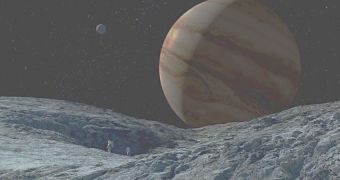Many scientists think that if on the Sun system there were another body than Earth harboring life, that would be Europa, the fourth largest of Jupiter's satellites.
A salty ocean was found beneath its icy surface. Europa compasses all the ingredients life requires: liquid water, an energy source (delivered by the tidal pull exerted by Jupiter's gravity) and organic chemicals.
If there is life on Europa, it is supposed to inhabit environments similar to deep ocean hot vents or to Antarctica's Lake Vostok. For this reason, Europa is a priority for further space missions.
Now researchers at Arizona State University in Tempe have made a global geological map of Europa in an effort to build a geological assessment of the peculiar moon and target future explorations. The team compiled the maps achieved by US-European Galileo probe, which investigated the Jupiter system from 1995 to 2003.
Several distinct geological units were identified on Europa, whose surface is young, active and smooth with few craters but punctuated by a web of fractures, probably where the icy shell has been torn apart by the tidal forces of Jupiter.
These traits and their age could reveal the geological history of the satellite. "When we make planetary maps, we're pretty limited by fieldwork, so 'ground truth-ing' is difficult - but not impossible, as we've found with the Mars Rovers," said Professor Ron Greeley, director of planetary geology.
"We have to rely on remote sensing information. On Earth, this is conventionally done in exploration for oil or mineral deposits. The data is used to make maps to figure out the best places to go and explore. That's what we're doing with Europa. We're trying to figure out what's what on the surface so we can go and explore further."
Galileo collected images at different resolutions, from 12.6 to 0.23km (7.8-0.14 miles) per pixel in multiple flybys. "We do not have global coverage, even at the lowest resolution. It is very non-uniform. Also, the illumination of the surface differs widely from one dataset to another," Greeley explained.
After 2015, NASA will send "flagship" robotic missions to Europa and Saturn's moons, Enceladus and Titan.

 14 DAY TRIAL //
14 DAY TRIAL //